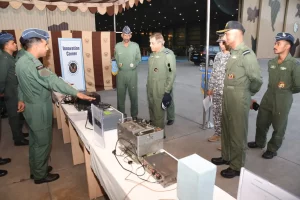A recent class was conducted on the topic of Number System in preparation for the Combined Defence Services (CDS) and Air Force Common Admission Test (AFCAT) Exams. This particular session focused on important sub-topics such as determining the number of zeroes at the end of a product, finding the number of factors of a given number, the number of even factors, the sum and product of factors, and determining factors that are perfect squares or divisible by a certain number. These concepts play a crucial role in competitive exams as they test a candidate’s ability to work with numbers quickly and accurately.
This blog will provide a detailed explanation of the topics discussed, followed by strategies essential to mastering these concepts for the CDS and AFCAT exams.
Key Concepts in the Number System
The number system is vast, but the concepts discussed in this class are essential for competitive exams. Let’s explore these subtopics in more detail.
1. Number of Zeroes at the End of a Product
One common type of problem in the CDS and AFCAT exams involves finding the number of zeroes at the end of a product of numbers. The number of zeroes at the end of a product depends on the number of factors of 10 present in the product. Since 10 is the product of 2 and 5, the number of zeroes is determined by the number of times 5 and 2 appear as factors, particularly focusing on how many pairs of 5s and 2s can be formed. However, since there are generally more factors of 2 than 5, the key is to count the factors of 5.
2. Number of Factors of a Number
To determine the number of factors of a number, you need to express the number as a product of its prime factors. The number of factors is then calculated based on the exponents of these prime factors. Understanding how to decompose a number into its prime factors is essential for solving these problems.
For example, if a number is expressed as a product of prime factors raised to certain powers, the number of factors can be determined by manipulating the exponents. This skill becomes particularly useful when dealing with large numbers in exams, where manually finding factors can be time-consuming.
3. Number of Even Factors
The number of even factors of a number is determined by focusing on the presence of the factor 2. Once you have determined the total number of factors, you can exclude the odd factors (which do not contain the factor 2) to find the even factors. Problems involving even factors often require you to break the number down into its prime factorization and apply logical deductions.
4. Sum and Product of Factors
The sum of the factors of a number is another concept frequently tested in exams. To calculate the sum of the factors, you need to work with the prime factorization of the number. The sum of the factors can be derived from the exponents of the prime factors. Similarly, the product of the factors can be found using specific formulas based on the total number of factors.
These types of problems often appear in exams where candidates are asked to determine the total sum or product of all factors for a given number, testing both your understanding of prime factorization and your ability to apply formulas effectively.
5. Number of Factors That Are Perfect Squares
A perfect square is a number that can be expressed as the square of an integer. To find how many factors of a given number are perfect squares, you need to examine the exponents of the prime factors of the number. For a factor to be a perfect square, all the exponents in its prime factorization must be even. This insight is key to solving such problems efficiently in exams.
6. Number of Factors Divisible by a Certain Number
Determining how many factors of a number are divisible by another given number involves comparing the prime factorization of both numbers. The factors of the first number that include all the prime factors of the second number are the ones that are divisible by the second number. This type of problem tests your ability to manipulate and compare prime factorizations quickly and accurately.
Strategies for Mastering These Concepts for CDS and AFCAT
Mastering the number system for competitive exams like CDS and AFCAT requires a combination of conceptual understanding and strategic preparation. Here are some essential strategies:
1. Strengthen Your Understanding of Prime Factorization
Since many of the problems discussed above rely on the prime factorization of numbers, it’s essential to be comfortable with breaking down numbers into their prime factors. Practice factorizing numbers quickly and efficiently. Focus on both small and large numbers to ensure you are prepared for all types of problems.
2. Memorize Key Divisibility Rules
Divisibility rules can help you factorize numbers more quickly, especially when dealing with large numbers in time-bound exams. Make sure you have memorized the divisibility rules for numbers like 2, 3, 5, 7, 11, and other commonly tested divisors. This will make it easier to find factors and solve related problems.
3. Practice Problems on Finding Factors and Their Properties
Regularly practice problems that involve finding the total number of factors, even factors, perfect square factors, and factors divisible by a certain number. The more you practice, the more familiar you will become with the different types of questions that can be asked in exams. Use previous years’ question papers to get a sense of the types of problems that frequently appear.
4. Work on Speed and Accuracy
Since competitive exams are time-limited, it’s important to solve problems both quickly and accurately. Practice solving number system problems under timed conditions to improve your speed. Focus on reducing calculation errors and applying logical shortcuts wherever possible.
5. Understand the Theorems Behind Remainder and Factor Problems
For problems involving remainders or unit digits, make sure you understand the relevant theorems, such as the Chinese Remainder Theorem or Fermat’s Little Theorem. These theorems can provide shortcuts for solving complex problems without having to perform lengthy calculations. Regularly review these theorems and practice applying them to various types of problems.
6. Use Shortcut Techniques
For problems involving the sum or product of factors, or the number of zeroes at the end of a product, familiarize yourself with the shortcut techniques. These can save you significant time during the exam. For example, instead of manually multiplying all the factors, you can use a formula to calculate the sum or product based on the prime factorization of the number.
7. Regular Revision
Since the number system is a fundamental topic that overlaps with other areas of mathematics, it’s important to revise it regularly. Include problems on the number system in your daily or weekly practice sessions to keep your skills sharp. Over time, your ability to solve these problems efficiently will improve.
Conclusion
The Number System forms the backbone of the quantitative section in competitive exams like CDS and AFCAT. Mastering concepts such as the number of zeroes at the end of a product, finding factors, sum and product of factors, and perfect square factors is essential for success. These concepts not only test your mathematical skills but also your ability to apply logical reasoning and time-saving strategies.
By focusing on prime factorization, practicing regularly, and understanding the key theorems and formulas related to the number system, you can improve both your speed and accuracy in solving these problems. With consistent effort, you will find that mastering the number system is not only achievable but also rewarding, as it will significantly boost your performance in the quantitative section of the CDS and AFCAT exams.



















